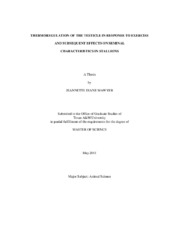| dc.description.abstract | Studies performed on stallions have characterized detrimental effects on semen quality resulting from thermal stress by testicular insulation, but few have investigated the effects of exercise-induced increases in core body temperature on stallion semen parameters. To our knowledge, this is the first study that correlates subcutaneous scrotal temperature and stallion spermatozoa quality using a subdermal scrotal thermal sensory device. Stallions were assigned to a non-exercised (non-ex; control; n=4) or exercised (ex; n=4) group. A motorized equine exerciser was used to work stallions 30 min/d for 4 d/wk during a 12-wk period from July through October. Temperatures (subcutaneous scrotal, subcutaneous neck, rectal, and ambient) were recorded before exercise, immediately after exercise, and 60 and 120 min post-exercise. Humidity data were obtained later to determine THI.
No deleterious effects were observed from implantation of thermal sensory devices. An interaction of treatment and time (P < 0.0001) was evident for rectal and neck temperatures. The relationship between scrotal and rectal temperatures was highest (rs =0.761), and other correlations existed between scrotal, neck, and ambient temperatures, as well. Mean rectal temperature in the ex group increased 1.9°C (P < 0.0001), while there was a slight increase in scrotal temperature of 0.8°C (P > 0.05) from 0 min to 22 min. Although an increase in core body temperature was successfully induced by exercise protocol, scrotal temperatures were not significantly affected, and no treatment effects were found in any of the semen parameters measured (P > 0.05). Therefore, no significant changes in fresh or cooled semen parameters resulted from exercise or increases in core body temperature resulting from exercise protocol used in this study.
Results of this study indicate that thermal sensory devices are a safe and effective way to measure subcutaneous scrotal and neck temperatures. Although an increase in core body temperature was successfully induced by exercise protocol, scrotal temperatures were not significantly affected, indicating efficient thermoregulation of the testes by the scrotum. Since the testes experienced no significant thermal insult during the exercise protocol, no significant changes in fresh or cooled semen parameters were evident as a result of exercise or elevated core temperature. | en |


